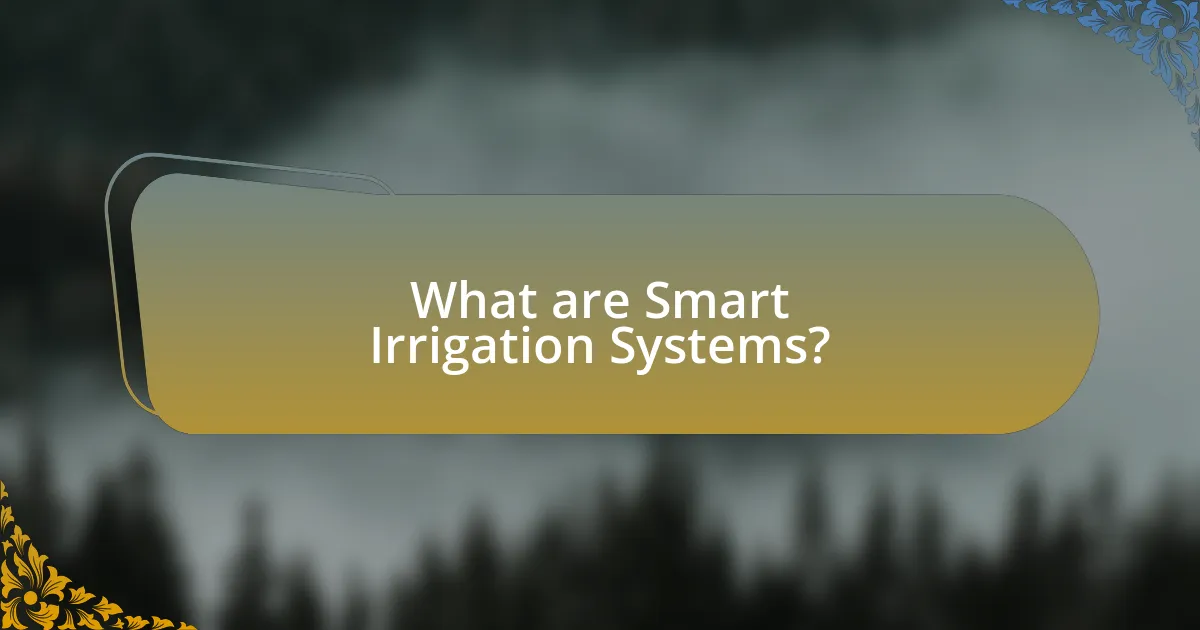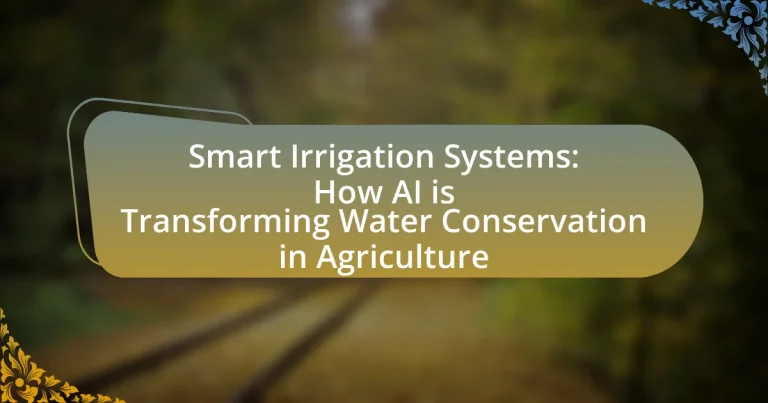Smart irrigation systems are advanced technologies that optimize water usage in agriculture by utilizing sensors, weather data, and automated controls. These systems can reduce water consumption by up to 30% compared to traditional methods while enhancing crop yield and sustainability. The article explores how smart irrigation functions, the technologies integrated within these systems, and the role of artificial intelligence in improving decision-making and efficiency. Additionally, it addresses the environmental benefits, challenges, and future trends associated with smart irrigation, providing insights into best practices for effective implementation and maintenance.

What are Smart Irrigation Systems?
Smart irrigation systems are advanced technologies designed to optimize water usage in agricultural practices. These systems utilize sensors, weather data, and automated controls to deliver precise amounts of water to crops based on their specific needs, significantly reducing water waste. Research indicates that smart irrigation can lead to water savings of up to 30% compared to traditional methods, enhancing both crop yield and sustainability in agriculture.
How do Smart Irrigation Systems function?
Smart irrigation systems function by utilizing sensors, weather data, and automated controls to optimize water usage for agricultural purposes. These systems collect real-time data on soil moisture levels, temperature, and precipitation, allowing them to determine the precise amount of water needed for crops. For instance, a study by the University of California found that smart irrigation can reduce water usage by up to 30% while maintaining crop yield. By integrating artificial intelligence, these systems can also adapt to changing environmental conditions, ensuring efficient water conservation and promoting sustainable agricultural practices.
What technologies are integrated into Smart Irrigation Systems?
Smart Irrigation Systems integrate several key technologies, including soil moisture sensors, weather data analytics, and automated control systems. Soil moisture sensors measure the water content in the soil, allowing for precise irrigation based on actual needs rather than schedules. Weather data analytics utilize real-time meteorological information to optimize watering schedules and reduce water waste. Automated control systems enable remote management and adjustments to irrigation practices, often through mobile applications or web interfaces, enhancing efficiency and responsiveness. These technologies collectively contribute to improved water conservation and agricultural productivity.
How do sensors contribute to the efficiency of Smart Irrigation Systems?
Sensors enhance the efficiency of Smart Irrigation Systems by providing real-time data on soil moisture, weather conditions, and plant water needs. This data allows for precise irrigation scheduling, ensuring that water is applied only when necessary, which reduces waste and conserves resources. For instance, soil moisture sensors can detect when the soil reaches a specific moisture level, triggering irrigation only when required, thereby optimizing water usage. Studies have shown that implementing sensor-based irrigation can lead to water savings of up to 30% compared to traditional methods, demonstrating their significant role in improving irrigation efficiency.
What role does AI play in Smart Irrigation Systems?
AI plays a crucial role in Smart Irrigation Systems by optimizing water usage through data analysis and predictive modeling. These systems utilize AI algorithms to process real-time data from soil moisture sensors, weather forecasts, and crop requirements, enabling precise irrigation scheduling. For instance, a study published in the journal “Agricultural Water Management” demonstrated that AI-driven irrigation systems can reduce water consumption by up to 30% while maintaining crop yield, showcasing the effectiveness of AI in enhancing water conservation in agriculture.
How does AI enhance decision-making in irrigation?
AI enhances decision-making in irrigation by analyzing vast amounts of data to optimize water usage and improve crop yields. Through machine learning algorithms, AI can process data from various sources such as weather forecasts, soil moisture levels, and crop health indicators. This data-driven approach allows for precise irrigation scheduling, ensuring that water is applied only when and where it is needed, thus reducing waste and promoting sustainability. For instance, a study by the University of California found that AI-driven irrigation systems can reduce water usage by up to 30% while maintaining crop productivity.
What algorithms are commonly used in AI-driven irrigation systems?
Common algorithms used in AI-driven irrigation systems include decision trees, support vector machines, and neural networks. Decision trees help in making irrigation decisions based on environmental data, while support vector machines classify soil moisture levels to optimize water usage. Neural networks analyze complex patterns in data, such as weather forecasts and crop requirements, to enhance irrigation efficiency. These algorithms enable precise water management, leading to improved crop yields and reduced water waste, as evidenced by studies showing up to 30% water savings in agricultural practices utilizing AI technologies.
What are the environmental benefits of Smart Irrigation Systems?
Smart Irrigation Systems significantly reduce water usage, leading to enhanced water conservation. These systems utilize advanced technologies such as sensors and weather data to optimize irrigation schedules, ensuring that crops receive the precise amount of water needed. According to a study by the USDA, implementing smart irrigation can reduce water consumption by up to 30% compared to traditional methods. Additionally, by minimizing overwatering, these systems help prevent soil erosion and nutrient runoff, which can harm local ecosystems. This efficient water management not only conserves a vital resource but also promotes healthier agricultural practices, contributing to overall environmental sustainability.
How do Smart Irrigation Systems contribute to water conservation?
Smart Irrigation Systems contribute to water conservation by utilizing advanced technology to optimize water usage in agricultural practices. These systems employ sensors and data analytics to monitor soil moisture levels, weather conditions, and crop needs, ensuring that water is applied only when necessary. For instance, a study by the University of California found that smart irrigation can reduce water usage by up to 30% while maintaining crop yield. This precise application minimizes waste and promotes sustainable water management in agriculture.
What impact do these systems have on soil health?
Smart irrigation systems positively impact soil health by optimizing water usage and reducing soil erosion. These systems ensure that crops receive the precise amount of water needed, which prevents over-saturation and minimizes nutrient leaching. Research indicates that efficient water management can enhance soil structure and promote beneficial microbial activity, leading to improved soil fertility. For instance, a study published in the journal “Agricultural Water Management” found that smart irrigation practices can increase soil organic matter by up to 15%, thereby enhancing overall soil health and productivity.
How can farmers implement Smart Irrigation Systems?
Farmers can implement Smart Irrigation Systems by integrating sensors, weather data, and automated controls to optimize water usage. These systems utilize soil moisture sensors to monitor the water needs of crops, ensuring irrigation occurs only when necessary. Additionally, farmers can leverage weather forecasts to adjust irrigation schedules, reducing water waste. Research indicates that smart irrigation can lead to water savings of up to 30% while maintaining crop yields, as demonstrated in studies conducted by the University of California Agriculture and Natural Resources.
What are the initial steps for adopting Smart Irrigation technology?
The initial steps for adopting Smart Irrigation technology include assessing current irrigation practices, identifying specific water management needs, and selecting appropriate smart irrigation systems. Assessing current practices involves evaluating existing irrigation methods and their efficiency, which helps in understanding areas for improvement. Identifying specific needs requires analyzing crop types, soil conditions, and climate factors to tailor the technology effectively. Selecting appropriate systems entails researching and choosing devices such as soil moisture sensors, weather-based controllers, and automated irrigation systems that align with the identified needs. These steps are crucial for optimizing water usage and enhancing agricultural productivity.
What factors should farmers consider when selecting a Smart Irrigation System?
Farmers should consider system compatibility, water source availability, soil type, crop requirements, and budget when selecting a Smart Irrigation System. Compatibility ensures that the system integrates well with existing infrastructure, while water source availability determines the system’s efficiency and sustainability. Soil type affects moisture retention and drainage, influencing irrigation needs. Crop requirements dictate the specific watering schedules and amounts necessary for optimal growth. Lastly, budget constraints guide the selection of technology and features that can be realistically implemented. These factors collectively ensure that the chosen system maximizes water conservation and enhances agricultural productivity.
What challenges do Smart Irrigation Systems face?
Smart Irrigation Systems face several challenges, including high initial costs, technical complexity, and data management issues. The high initial costs can deter farmers from adopting these systems, as they require significant investment in technology and infrastructure. Technical complexity arises from the integration of various components, such as sensors, controllers, and software, which can be difficult to manage and maintain. Additionally, data management issues occur due to the vast amounts of data generated, necessitating effective analysis and interpretation to optimize irrigation practices. These challenges can hinder the widespread adoption and effectiveness of Smart Irrigation Systems in agricultural water conservation.
How can technical issues be resolved in Smart Irrigation Systems?
Technical issues in Smart Irrigation Systems can be resolved through systematic troubleshooting, software updates, and hardware maintenance. Systematic troubleshooting involves identifying the specific malfunction, such as connectivity issues or sensor failures, and addressing them through diagnostic tools. Regular software updates ensure that the system operates with the latest features and security patches, which can prevent bugs and improve performance. Additionally, routine hardware maintenance, including cleaning sensors and checking for leaks, helps maintain optimal functionality. Research indicates that proactive maintenance can reduce system downtime by up to 30%, enhancing overall efficiency in water conservation efforts.
What are the economic barriers to adopting Smart Irrigation Systems?
The economic barriers to adopting Smart Irrigation Systems include high initial investment costs, ongoing maintenance expenses, and the need for specialized training. High initial investment costs can deter farmers, as the price of advanced technology and installation can be significant, often ranging from thousands to tens of thousands of dollars. Ongoing maintenance expenses further complicate adoption, as these systems require regular upkeep and potential repairs, which can strain budgets. Additionally, the need for specialized training to effectively operate and manage these systems can create further financial hurdles, as farmers may need to invest time and resources into learning new technologies. These factors collectively contribute to the reluctance in adopting Smart Irrigation Systems in agriculture.
What future trends can we expect in Smart Irrigation Systems?
Future trends in Smart Irrigation Systems include increased integration of AI and machine learning for real-time data analysis and decision-making. These technologies enable systems to optimize water usage based on weather forecasts, soil moisture levels, and crop needs, leading to more efficient irrigation practices. For instance, a study by the University of California found that AI-driven irrigation systems can reduce water usage by up to 30% while maintaining crop yields. Additionally, the adoption of IoT devices will enhance connectivity and data collection, allowing for more precise irrigation management. As these technologies evolve, we can expect greater automation and user-friendly interfaces, making smart irrigation systems more accessible to farmers.
How is the integration of IoT shaping the future of Smart Irrigation?
The integration of IoT is revolutionizing Smart Irrigation by enabling real-time data collection and analysis for optimized water usage. IoT devices, such as soil moisture sensors and weather stations, provide precise information on environmental conditions, allowing farmers to make informed decisions about irrigation schedules. This technology reduces water waste and enhances crop yield, as evidenced by a study from the University of California, which found that IoT-based irrigation systems can reduce water usage by up to 30% while improving crop productivity. Thus, IoT is crucial in shaping a sustainable and efficient future for Smart Irrigation.
What advancements in AI are anticipated for Smart Irrigation Systems?
Anticipated advancements in AI for Smart Irrigation Systems include enhanced predictive analytics, real-time data processing, and machine learning algorithms for optimized water usage. These advancements will enable systems to analyze weather patterns, soil moisture levels, and crop needs more accurately, leading to efficient irrigation schedules. For instance, AI-driven models can predict irrigation requirements based on historical data and current environmental conditions, reducing water waste by up to 30% according to studies by the University of California. Additionally, integration with IoT devices will facilitate automated adjustments in irrigation practices, ensuring that water is applied precisely when and where it is needed.
What best practices should be followed for effective Smart Irrigation?
Effective smart irrigation requires the implementation of several best practices, including the use of soil moisture sensors, weather data integration, and automated irrigation scheduling. Soil moisture sensors provide real-time data on soil conditions, allowing for precise watering based on actual needs rather than schedules, which can lead to water conservation. Integrating weather data helps to adjust irrigation based on rainfall forecasts and temperature, further optimizing water usage. Automated scheduling systems can ensure that irrigation occurs during optimal times, reducing evaporation losses. According to a study by the University of California, implementing these practices can reduce water usage by up to 30% while maintaining crop health.
How can data analytics improve irrigation efficiency?
Data analytics can improve irrigation efficiency by enabling precise water management through real-time data collection and analysis. By utilizing sensors and IoT devices, farmers can gather data on soil moisture levels, weather patterns, and crop water needs. This data allows for the optimization of irrigation schedules, reducing water waste and ensuring that crops receive the appropriate amount of water at the right time. For instance, a study by the University of California found that data-driven irrigation practices can reduce water usage by up to 30% while maintaining crop yields. This demonstrates that data analytics not only enhances water conservation but also supports sustainable agricultural practices.
What maintenance tips ensure longevity of Smart Irrigation Systems?
Regular maintenance of Smart Irrigation Systems is essential for their longevity. Key maintenance tips include checking and cleaning filters and emitters to prevent clogs, inspecting and repairing leaks in pipes and connections to ensure efficient water delivery, and regularly updating software to optimize system performance. Additionally, seasonal adjustments based on weather conditions can enhance water conservation efforts. These practices help maintain system efficiency and extend the operational lifespan of the technology.


